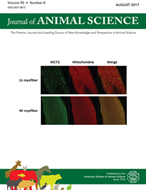-
Views
-
Cite
Cite
M. Bonnet, Y. Faulconnier, C. Leroux, C. Jurie, I. Cassar-Malek, D. Bauchart, P. Boulesteix, D. Pethick, J. F. Hocquette, Y. Chilliard, Glucose-6-phosphate dehydrogenase and leptin are related to marbling differences among Limousin and Angus or Japanese Black × Angus steers,, Journal of Animal Science, Volume 85, Issue 11, November 2007, Pages 2882–2894, https://doi.org/10.2527/jas.2007-0062
Close - Share Icon Share
ABSTRACT
This work investigated the metabolic basis for the variability of carcass and i.m. adiposity in cattle. Our hypothesis was that the comparison of extreme breeds for adiposity might allow for the identification of some metabolic pathways determinant for carcass and i.m. adiposity. Thus, 23- to 28-mo-old steers of 3 breeds, 2 with high [Angus or Japanese Black × Angus (J. Black cross)] and 1 with low (Limousin) i.m. and carcass adiposity, were used to measure activities or mRNA levels, or both, of enzymes involved in de novo lipogenesis [acetyl-coA carboxylase, fatty acid synthase (FAS), glucose-6-phosphate dehydrogenase (G6PDH), malic enzyme], circulating triacylglycerol (TAG) uptake (lipoprotein lipase), and fatty acid esterification (glycerol-3-phosphate dehydrogenase), as well as the mRNA level of leptin, an adiposity-related factor. In a first study, enzyme activities were assayed in the s.c. adipose tissue (AT), the oxidative rectus abdominis, and the glycolytic semitendinosus muscles from steers finished for 6 mo. Compared with Angus or J. Black cross, Limousin steers had a 27% less (P = 0.003) rib fat thickness, and 23 and 29% less (P ≤ 0.02) FAS and G6PDH activities in s.c. AT. In rectus abdominis and semitendinosus, the 75% less (P < 0.001) TAG content was concomitant with 50% less (P < 0.001) G6PDH activity. In a second study, enzyme activities plus mRNA levels were assayed in an oxido-glycolytic muscle, the longissimus thoracis (LT), in the i.m. AT dissected from LT, and in s.c. AT from the same Limousin steers and from Angus steers finished for 10 mo. Compared with Angus, the 50% less (P < 0.001) rib fat thickness in Limousin contrasted with the 1.1- to 5.8-fold greater (P ≤ 0.02) mRNA levels or activities, or both, of acetyl-coA carboxylase, G6PDH, lipoprotein lipase, and glycerol-3-phosphate dehydrogenase in s.c. AT. Conversely, the 90% less (P < 0.001) TAG content in Limousin LT was concomitant to the 79 and 83% less (P ≤ 0.002) G6PDH activity and leptin mRNA level. Such differences could arise from a greater number of adipocytes in LT from Angus steers because no difference was found between Limousin and Angus for G6PDH activity and leptin mRNA in i.m. AT. We conclude that FAS and G6PDH in s.c. AT could be involved in differences in carcass adiposity, but this relationship disappeared when the fatness increased strongly. Leptin and G6PDH are related to the expression of marbling whatever the body condition and thus could be relevant indicators of marbling in beef cattle.





